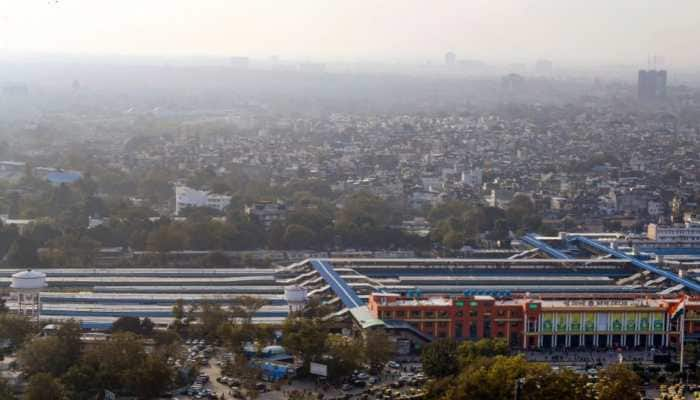DNA Exclusive: Indian Naval force gets new ensign, a look at Navy's glorious history
In today’s DNA, Zee Media’s Rohit Ranjan has made a detailed analysis of the new Swadeshi Navy ensign and its connection with our history and what the commissioning of INS Vikrant in the defence forces means for India’s defence sector.
Trending Photos
)
New Delhi: As the country moves ahead towards its vision of Atmanirbhar Bharat, the Indian Navy on Friday received its first indigenous aircraft carrier Mahabali INS Vikrant. This marks India’s ambitious efforts to make the defence sector self-reliant amid the global conflicts and uncertainty in the current scenario. Prime Minister Narendra Modi dedicated INS Vikrant to the Navy at a glittering event in Kochi Apart from this, the Indian Navy also got its new ensign finally doing away with the British colonial era sign that the defence force had been carrying for so long. In addition to the prime minister, Defence Minister Rajnath Singh and NSA Ajit Doval were also present on the occasion.
In today’s DNA, Zee Media’s Rohit Ranjan has made a detailed analysis of the new Swadeshi Navy ensign and its connection with our history and what the commissioning of INS Vikrant in the defence forces means for India’s defence sector.
How’s the new Navy ensign different?
The old Indian Navy featured a St. George's Cross, which was considered a symbol of slavery even after independence and reminded the country of British colonialism. Saint George was an old saint of Britain, whom the British used on their flag as a symbol to honour him. We have been using this symbol for many years after Independence. It was also removed for about 4 years in between but then was introduced back.
#DNA: भारतीय नौसेना को आज उनका स्वदेशी एयरक्राफ्ट कैरियर INS विक्रांत मिल गया, साथ में नया ध्वज भी #INSVikrant #IndianNavy @irohitr pic.twitter.com/OnHXQYMoFk — Zee News (@ZeeNews) September 2, 2022
Now the new flag of the Indian Navy reminds India of its glorious history the Indian Navy. The white flag has the tricolour on the left, on the top while on the right side, there is a golden-coloured octagon i.e. octagonal shape with thick stripes. Inside this, another octagon of thin stripes is made. Navy blue colour is visible inside this octagon. The octagon has the sign of the Ashoka Pillar, below which the anchor of the ship is visible. It is written 'Shan No Varunah'.
#DNA: भारतीय नौसेना ने गुलामी के इस प्रतीक को आखिरकार मिटा दिया#INSVikrant #IndianNavy @irohitr @kmmishratv pic.twitter.com/re7zS4vjye — Zee News (@ZeeNews) September 2, 2022
Written in Sanskrit, this word is the motto of the Indian Navy, which means 'Varun Dev be auspicious for us.’ In Hindu culture, Varun Dev is called the god of the sea. That is why the Navy has used its motto in its new flag.
The glorious history of the Indian Naval force
It is believed that India has never been a naval power. It is also generally said that no Indian has ever crossed the maritime boundaries and gone to other countries. But the real history of the Indian Naval Forces is far from what is known to us.
#DNA: भारतीय नौसेना अपने इस नए ध्वज के जरिए पूरी दुनिया को अपनी शक्ति का इतिहास बताने जा रही है#INSVikrant #IndianNavy @irohitr @kmmishratv pic.twitter.com/2ucBWfuGhx — Zee News (@ZeeNews) September 2, 2022
India's maritime borders are about 7,516 km long. They go from Gujarat to West Bengal. In fact, our maritime boundary is said to be the 18th largest maritime boundary in the world. If seen, India is surrounded by the Indian Ocean, Arabian Sea and Bay of Bengal on 3 sides.
A closer look at the ancient map of India shows that the maritime trade of countries around the world used to pass through the Indian border. From this, you can understand that India was always at the centre of the world's maritime trade.
In the 17th century, Chhatrapati Shivaji also built a powerful sea fleet to protect maritime boundaries.
Not only this, Shivaji's thinking was far ahead, he also prepared sea forts to protect the maritime boundaries.
Watch today's full analysis with Rohit Ranjan here!
भारत में आधे से ज़्यादा डॉक्टर फर्ज़ी?..बड़ा खुलासा, देखिए #DNA LIVE #RohitRanjan के साथ | @irohitr
+'मुन्नाभाई' MBBS..नजदीकी क्लिनिक में उपलब्ध !
+फिंगर्स से 'प्रिंट्स' चुराने वाला गिरोह
+नौसेना से अंग्रेज़ों का 'आखिरी निशान' ख़त्म https://t.co/Vik30GFEor — Zee News (@ZeeNews) September 2, 2022
Stay informed on all the latest news, real-time breaking news updates, and follow all the important headlines in india news and world News on Zee News.
Live Tv







)
)
)
)
)
)
)
)
)
)
